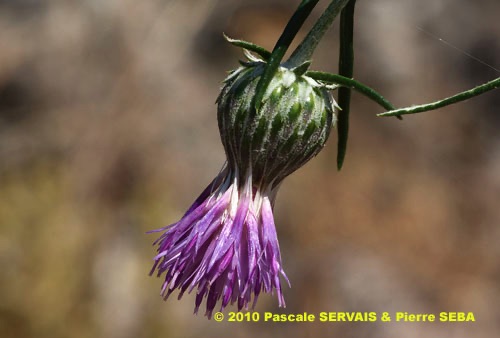
Ptilostemon chamaepeuce (L.) Less.
Fam. : Asteraceae
© Pascale SERVAIS & Pierre SEBA, 2018. Tilo Botanica: Flore de Tilos et du Dodécanèse / Flora of Tilos and of the Dodecanese
English translation by Brenda Bradbury, Howard Bradbury and Stéphane Léonard
Arbrisseau hermaphrodite, non épineux, à tiges souvent blanches et duveteuses.
Feuilles alternes, simples, en forme d’aiguille, persistantes, à duvet argenté dessous et à bords enroulés.
Fleurs pourpres, roses ou blanches, longues de 20 à 25 mm, réunies en capitules de 14 à 30 mm, solitaires ou en bouquets peu fournis. Capitules portés par un long pédoncule peu feuillé. Bractées de l’involucre ovales à lancéolées, non étalées ou à peine, pointues mais sans épine rigide. Ovaire infère.
Fruits, longs akènes à poils plumeux.
___________________________
Shrub hermaphrodite, nonspiny. Stems often white and hoary.
Leaves alternate, simple, in the shape of a needle, persistent, with a silver-coloured hoary pubescence below and with coiled edges.
Flowers purple, pink or white, from 20 to 25 mm long, joined together in capitula from 14 to 30 mm, solitary or in loose clusters. Capitula carried by a long not very leafy peduncle. Bracts of the involucre ovate to lanceolate, not or scarcely spread out, pointed but without a rigid thorn. Ovary inferior.
Fruits, long achenes with feathery hairs.
Descripteurs / Identifying features
1
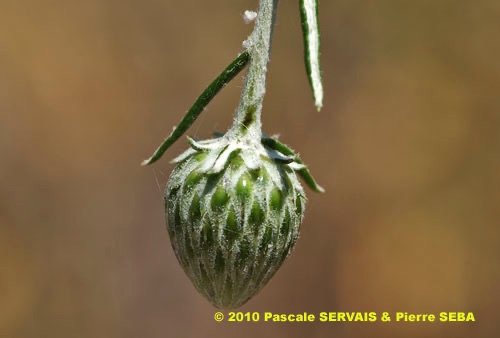
2
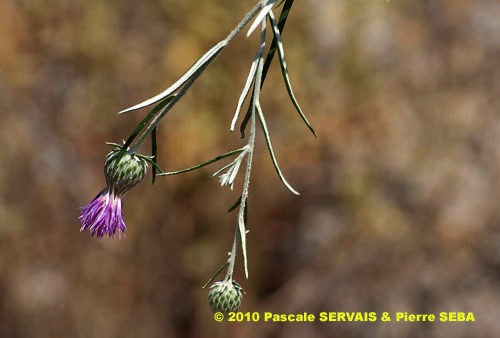
3
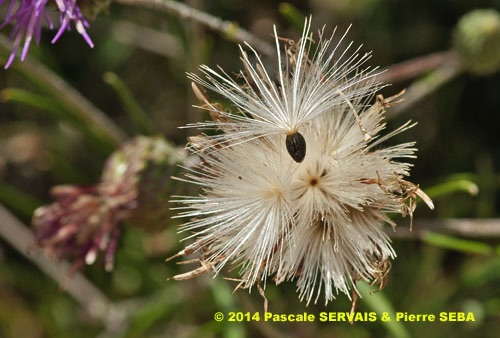
4
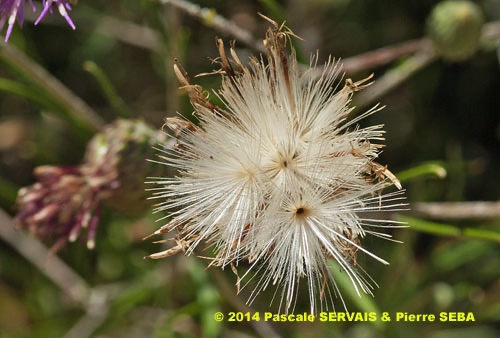
5

6
Étymologie / Etymology :
Ptilostemon : nom créé par les botanistes [ < πτίλον, -ου (nom)
= la plume + στήμων, -ονος (nom) = le fil ] = plante qui a des fils
plumeux, en référence aux fruits surmontés d’aigrettes plumeuses.
Chamaepeuce : emprunt du latin chamaepeuce, -es (nom)
= le mélèze nain, nom donné à la plante par Pline, naturaliste latin mort
en 79 apr. J.-C., forme latinisée du grec ancien χαμαιπεύκη, -ης (nom)
[ < χαμαί (adv.) = par terre, au sol, nain + πεύκη, -ης (nom) = le pin ]
= le pin nain, nom donné à la plante par Dioscoride, médecin et
botaniste grec mort en 90 apr. J.-C., en référence à l’apparence de la
plante qui ressemble à un pin en forme de buisson.
Ptilostemon : name created by botanists [ < πτίλον, -ου (noun)
= pen + στήμων, -ονος (noun) = thread ] = plant with feathery threads,
referring to the fruits surmounted by feathery pappus.
Chamaepeuce : borrowed from Latin chamaepeuce, -es (noun) = dwarf
larch, name given to the plant by Plinius, Latin naturalist died in 79 AD,
Latinized form of the Classical Greek χαμαιπεύκη, -ης (noun)
[ < χαμαί (adv) = on the ground, dwarf + πεύκη, -ης (noun) = pine ]
= dwarf pine, name given to the plant by Dioscorides, Greek doctor and
botanist died in 90 AD, referring to the shrubby, pine-like appearance
of the plant.
Synonymes / Synonyms :
Chamaepeuce alpini Jaub. & Spach
Cirsium chamaepeuce (L.) Ten.
Serratula chamaepeuce L.
Noms vernaculaires / Common names :
Nom français / French name :
Ptilostémon.
Noms grecs / Greek names :
Πτιλόστεμον η χαμαιπεύκη — Πτιλόστεμον το πευκοειδές.
Noms anglais / English names :
Reater chamaepeuce — Shrubby ptilostemon.
Nom allemand / German name :
Scheinfichten-Kratzdistel.
Nom italien / Italian name :
Cardo lineare.
Habitat :
Lieux pierreux.
Stony places.
Île / Island :
Tilos.
Hauteur / Height range :
De 30 cm à 1 m.
From 30 cm to 1 m.
Floraison / Flowering time :
De mai à juin.
From May to June.
Groupe / Classification :
Dicotylédones.
Dicotyledons.
Pérennité / Lifespan :
Vivace.
Perennial.
Description :
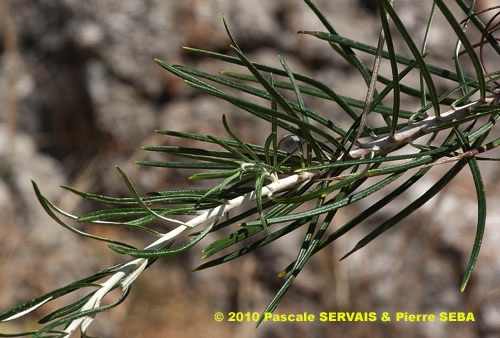
7
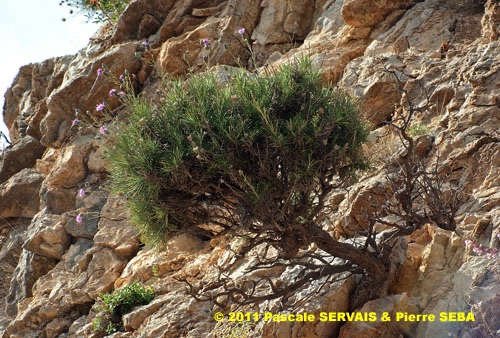
8
Photo 1 :
Localisation / Location : Tilos, Livadia, Gorges de Lethra
Date : 02/05/2010
GPS : Lat. 36,43136° N / Long. 27,38144° E / Alt. 102 m
Type : Photographie numérique / Digital Photograph (10 mégapixels)
Photo 2 :
Localisation / Location : Tilos, Livadia, Gorges de Lethra
Date : 02/05/2010
GPS : Lat. 36,43136° N / Long. 27,38144° E / Alt. 102 m
Type : Photographie numérique / Digital Photograph (10 mégapixels)
Photo 3 :
Localisation / Location : Tilos, Livadia, Gorges de Lethra
Date : 02/05/2010
GPS : Lat. 36,43136° N / Long. 27,38144° E / Alt. 102 m
Type : Photographie numérique / Digital Photograph (10 mégapixels)
Photo 4 :
Localisation / Location : Tilos, Megalochorio, Plaine d’Erystos
Date : 29/05/2014
GPS : Lat. 36,44086° N / Long. 27,35253° E / Alt. 23 m
Type : Photographie numérique / Digital Photograph (10 mégapixels)
Photo 5 :
Localisation / Location : Tilos, Megalochorio, Plaine d’Erystos
Date : 29/05/2014
GPS : Lat. 36,44086° N / Long. 27,35253° E / Alt. 23 m
Type : Photographie numérique / Digital Photograph (10 mégapixels)
Photo 6 :
Localisation / Location : Tilos, Livadia, Gorges de Lethra
Date : 21/09/2008
GPS : Lat. 36,43136° N / Long. 27,38144° E / Alt. 102 m
Type : Photographie numérique / Digital Photograph (10 mégapixels)
Photo 7 :
Localisation / Location : Tilos, Livadia, Gorges de Lethra
Date : 02/05/2010
GPS : Lat. 36,43136° N / Long. 27,38144° E / Alt. 102 m
Type : Photographie numérique / Digital Photograph (10 mégapixels)
Photo 8 :
Localisation / Location : Tilos, LIvadia, Pano Meri
Date : 23/05/2011
GPS : Lat. 36,41015° N / Long. 27,41162° E / Alt. 139 m
Type : Photographie numérique / Digital Photograph (10 mégapixels)

Google Maps
Google Maps
Google Maps
Google Maps
Google Maps
Google Maps
Google Maps
Google Maps